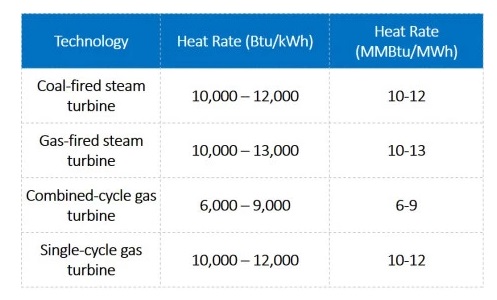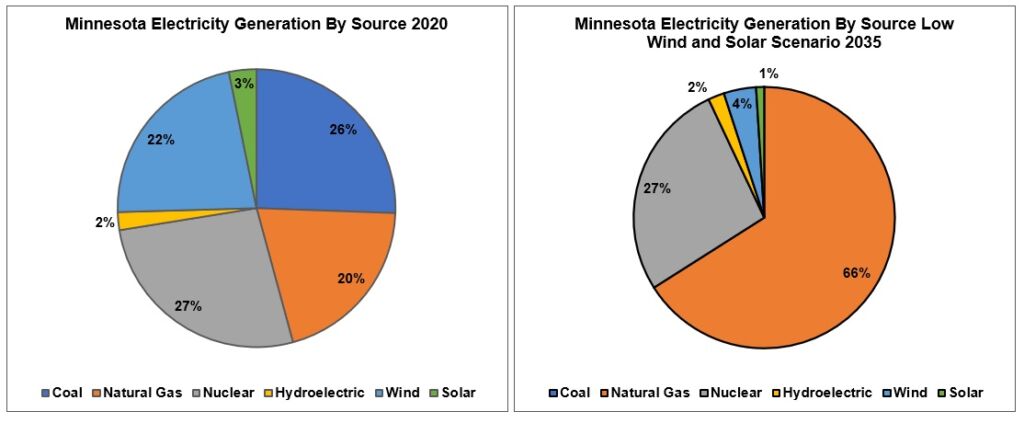Coal generation to increase due to higher natural gas prices
The U.S. Energy Information Administration has forecast electricity generation from natural gas plants to fall due in 2021 to rising natural gas prices. Coal generation will help shoulder the load due to its lower cost.
The agency writes:
We expect the share of electric power generated from natural gas in the United States will average 35% in both 2021 and 2022, down from 39% in 2020. The forecast share for natural gas as a generation fuel declines in response to an 85% increase in the average delivered natural gas price for electricity generators, from an average $2.39 per million British Thermal Units (MMBtu) in 2020 to an average $4.41/MMBtu in 2021.
This is a major increase in the cost of natural gas that has important implications for electricity prices.
The table below shows heat rates for different kinds of power plants. Heat rates measure the amount of fuel needed to generate one megawatt-hour (MWh) of electricity. These are expressed in million Btus (MMBtu) per MWh. The heat rate is similar to a gas mileage rating, but in this case, a lower heat rate is better, as it means the power plant is more efficient at producing electricity using less fuel.

Coal and natural gas prices are often measured in dollars per MMBtu. Delivered coal prices in Minnesota in 2019 were $2.02 per MMBtu. This means we would multiply the cost per MMBtu by the heat rate per MWh, in this case, 10 or 12, to find the cost of the coal burned to generate one MWh of electricity. In this case, $2.02 x 10 MMBtu/MWh = $20.2/MWh.
When natural gas prices are low, it is cheaper to use a combined-cycle gas turbine than coal because these types of power plants are more efficient at converting fuel into electricity. At $2.39/MMBtu and a heat rate of 6, it only costs $14.34 per MWh for natural gas, but at $4.41/MMBtu, the cost jumps up to $26.46 per MWh, making natural gas a more expensive option.
EIA writes there will be a significant gas-to-coal switch, as a result:
As a result of the higher expected natural gas prices, the forecast share of generation from coal rises from 20% in 2020 to 24% this year and to 23% next year. New additions of solar and wind generating capacity contribute to our expectation that the renewables share of U.S. generation will rise from 20% in 2020 to 21% in 2021 and to 22% in 2022. The nuclear share of U.S. generation declines from 21% in 2020 to 20% in 2021 and to 19% in 2022 as a result of retiring capacity at some nuclear power plants.
Despite the fact that we build more and more wind and solar facilities every year, they are unable to meaningfully increase output to replace natural gas when prices are high, which is why coal generation will increase more than renewable generation in the coming years.
This is why closing our coal plants before the end of their useful lifetime is such a bad idea, and why Minnesota should keep its nuclear plants online as long as possible. Coal and nuclear plants provide an important hedge against rising electricity costs due to increasing natural gas prices.
Renewable energy special interest groups pretend that wind and solar can provide this necessary hedge, but these are public relations talking points, not a sound energy policy. Yes, wind and solar can alleviate upward pressure on natural gas prices, if the weather is cooperating.
If it is not cooperating, however, wind and solar make the problem worse by needing natural gas plants to generate electricity. You can see how this would work in the graph below, which shows a hypothetical day in 2035 with low wind and solar output and no coal generation.

Not only do coal and nuclear plants provide crucial reliability aspects to the grid that natural gas simply cannot replicate, it also protects consumers from huge spikes in the cost of natural gas. Minnesotans should support the continued operation of reliable baseload plants until the end of their useful lifetime.